Honors and Awards for 2020
Dr. Jinyu Zhang Wins the Robert Mitchum Award
October 14, 2020

Bureau researcher Dr. Jinyu Zhang and his co-authors have been awarded the 2020 Robert Mitchum Award for their paper "Can sediment supply variations create sequences? Insights from stratigraphic forward modelling," which appeared in volume 31 of Basin Research in April 2019.
The annual Robert Mitchum Award is presented by the European Association of Geoscientists and Engineers (EAGE) to the author of the best paper published in Basin Research during the preceding calendar year. The winning paper must meet high scientific standards and should represent a significant contribution to one or more of the disciplines represented by the journal.
Dr. Zhang's excellent paper emphasizes the importance of sediment discharge and water discharge on sequence development. The study involved numerical stratigraphic modelling to simulate shoreline migrations in response to sea-level changes. The work was a joint effort between the Bureau's STARR program and the University of Liverpool.
Please join us in congratulating Dr. Zhang on his achievement and be sure to check out his award-winning publication.
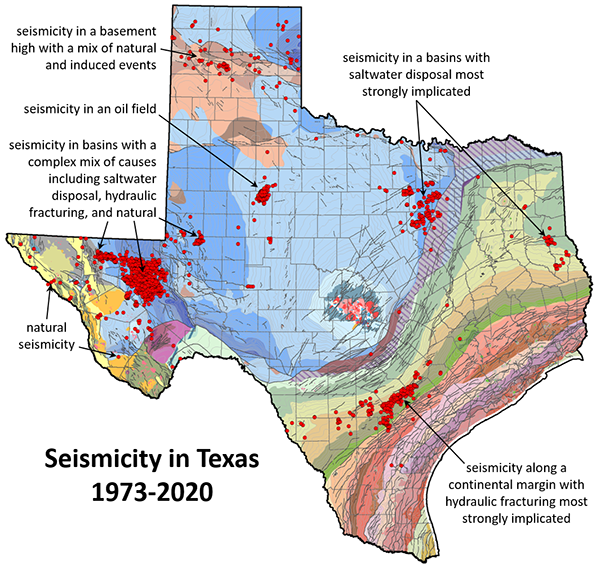
Click map to view larger.
Dr. Peter Hennings Wins Best Paper Award from AAPG
June 1, 2020
Dr. Peter Hennings has been selected by the American Association of Petroleum Geologists (AAPG) Division of Environmental Geosciences (DEG) to receive the DEG Best Paper Award for his oral presentation titled “The Geology of Active Earthquake Sequences in Texas.” Dr. Hennings’ presentation, given at the AAPG Annual Conference and Exhibition in 2019, stood out for the high scores and remarks it received from judges.
The presentation discussed recent earthquake data gathered by the TexNet Earthquake Monitoring Network and provided an overview of TexNet’s strides in interpreting the seismicity of local and regional areas with earthquake activity. Each area is unique in its geologic setting, history of industry activity, and history of earthquake sequences. Comparing data from each of these areas provides researchers with insights into the causes of earthquakes and what can be done to mitigate hazards.
The Bureau congratulates Dr. Hennings and the TexNet team whose research was featured in the presentation: Dr. Alexandros Savvaidis, Dr. Jean-Philippe Nicot, Dr. Peter Eichhubl, Casee Lemons, Dr. Katie Smye, Lily Horne, Robin Dommisse, and Dr. Owen Callahan. For more information about the TexNet program, you can contact Dr. Peter Hennings or visit the TexNet website.
TexNet Research Among Top 10% Most Downloaded Papers from JGR Solid Earth
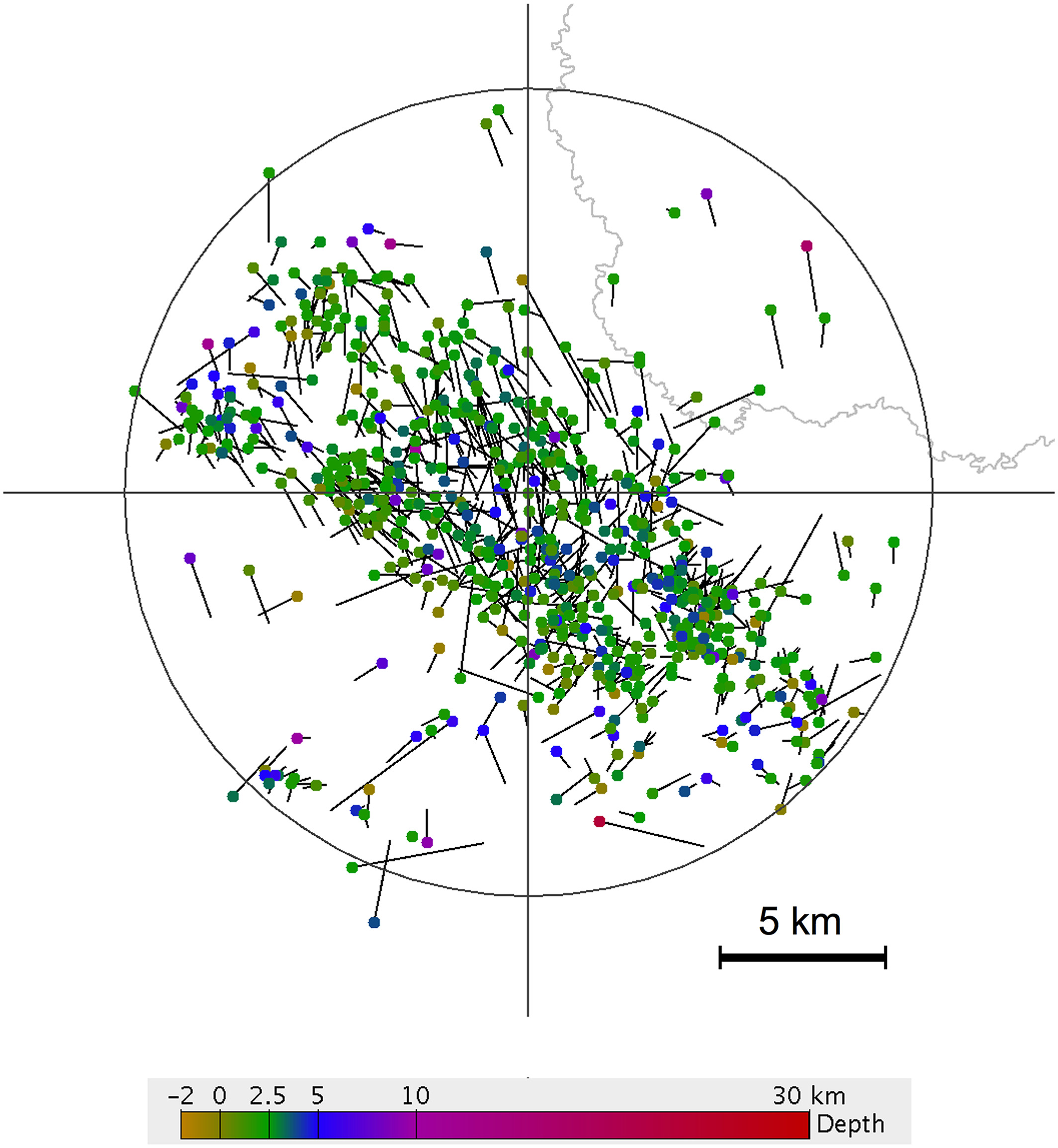
A model showing probabilistic, proxy ground-truth (PPGT) corrections (dots, colored by depth) and their epicenter shift (lines).
May 7, 2020
Bureau researcher and TexNet principal investigator Dr. Alexandros Savvaidis was recently informed by the Journal of Geophysical Research: Solid Earth (JGR) that his October 2019 paper is among the journal’s top 10% most downloaded papers in recent publication history. JGR determines this milestone by reviewing which papers published during a 2-year period receive the most downloads within 12 months of their publication. Dr. Savvaidis’ work has achieved this distinction despite having been published for only about 7 months at the time of writing.
Dr. Savvaidis’ paper, titled “Improving Absolute Earthquake Location in West Texas Using Probabilistic, Proxy Ground-Truth Station Corrections,” discusses his work in improving the accuracy of earthquake location monitoring by statistically associating earthquakes with fracturing activity—a cause of human-induced earthquakes. Known locations of fracturing activity are used as proxy ground-truth events to calculate the seismic network. Accurately determining the location and depth of seismic events is critical to monitoring earthquakes and the threat they pose to public safety and infrastructure.
To learn more about the Bureau’s state-funded earthquake monitoring program, TexNet, you can contact Alexandros Savvaidis or visit the TexNet website.
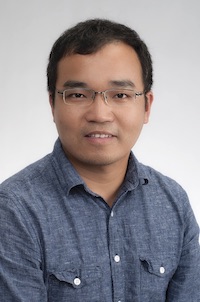
Former Bureau Postdoc Wins the Karcher Award
April 28, 2020
Dr. Xinming Wu, a former Bureau postdoc from 2016 to 2019, was awarded the 2020 J. Clarence Karcher Award by the Society of Exploration Geophysicists. This is a highly prestigious and competitive award given “in recognition of significant contributions to the science and technology of exploration geophysics by a young geophysicist of outstanding abilities who, in the unanimous opinion of the Honors and Awards Committee and the Board of Directors, merits such recognition.”
Dr. Wu worked with Dr. Sergey Fomel during his time at the Bureau and is the third of Dr. Fomel’s postdocs to get the Karcher award in the last 3 years. Dr. Tieyuan Zhu, now an assistant professor of geophysics at Pennsylvania State University, received one in 2018, and Dr. Hejun Zhu, currently an assistant professor at The University of Texas at Dallas, received another in 2019. Dr. Wu is now at the University of Science and Technology of China, where he continues to collaborate with Dr. Fomel.
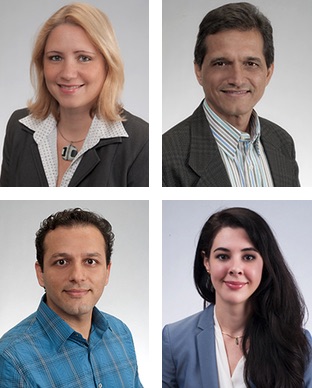
Tinker Family BEG Publication Award winners (from top left to bottom right) Vanessa Nuñez-López, Ramón Gil-Egui, Seyyed A. Hosseini, and Emily Moskal
Bureau First Author Publication Awards 2019
April 14, 2020
Although leaders and researchers of the Bureau of Economic Geology could not dine together this year to celebrate the annual First Author Publication Awards, the Bureau recognizes another fruitful year of impactful publications—the Bureau’s most vital product. Leadership applauds the 48 Bureau first authors of peer-reviewed papers published in 2019. Let us all take this opportunity for the diverse Bureau family to come together, share excitement about research and publication success in a wide array of topics, and honor the work of a broad spectrum of authors. Last year, Bureau researchers published 135 peer-reviewed papers, first-authoring 63 of these and coauthoring another 22 first-authored by their graduate students.
The highlight of the First Author Publication Awards is the presentation of the Tinker Family BEG Publication Award, “given in recognition of an exemplary publication of demonstrated or expected scientific or economic impact, or that otherwise increases the visibility of the Bureau scientific community.”
This year, the Bureau’s Vanessa Nuñez-López, along with coauthors Ramón Gil-Egui, Seyyed A. Hosseini, and Emily Moskal, receive the award for “Environmental and operational performance of CO2-EOR as a CCUS technology: a Cranfield example with dynamic LCA considerations” (coauthored by Gil-Egui and Hosseini) and “Potential of CO2-EOR for near-term decarbonization” (coauthored by Moskal). These papers represent exemplary publication of societal relevance to carbon management. Runners-up include Sahar Bakhshian and Hosseini, Zoltán Sylvester and Jacob A. Covault, and Qian Yang and Bridget R. Scanlon.
Please join us in congratulating all of these successful authors. We look forward to celebrating with them now and during next year’s combined 2020–2021 First Author Publication Awards dinner.
AEC Team Wins Best Paper Award
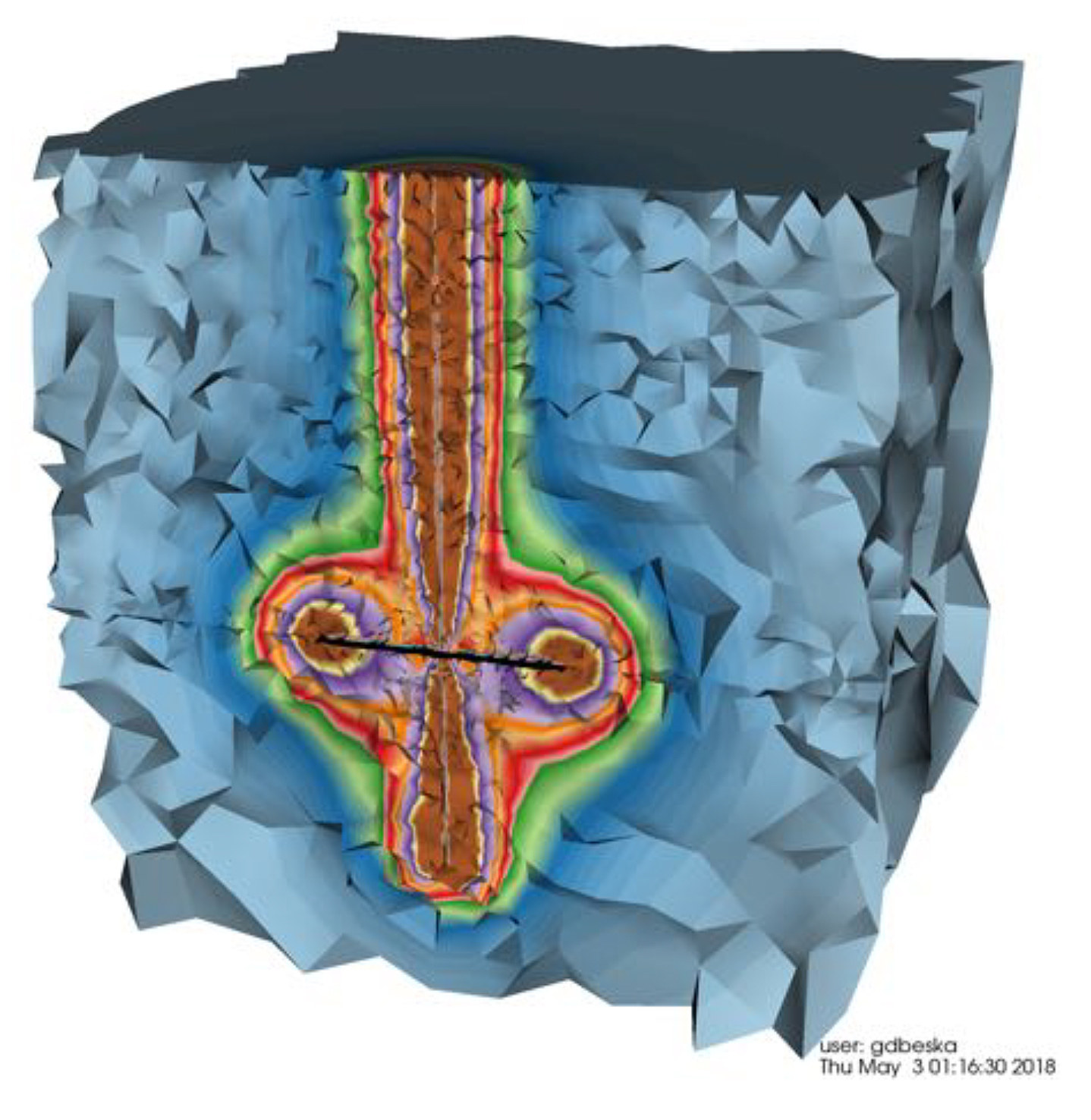
A model of the simulation’s available energy density.
February 18, 2020
Mohsen Ahmadian and David Chapman of the Bureau’s Advanced Energy Consortium (AEC) coauthored a groundbreaking paper which has won the 2019 Best Paper of the Year Award from the Journal of Environmental and Engineering Geophysics. The paper is entitled “Power density distribution in subsurface fractures due to an energized steel well-casing source” and explores a completely new concept for supplying power to subsurface nanosensors. The study team was created out of a collaboration with Sandia National Laboratories, which also funded the study.
Simulations indicate that a combination of steel wellbore casing and electromagnetic (EM) additives could supply continuous electrical power to embedded nanosensors previously deployed during well completion. These sensors would then be able to communicate measured data back up the wellbore to operators even decades after deployment. The models also counterintuitively indicate that the electrical charge from the casing could propagate through the EM proppant, with higher energy density at the tips of any filled fractures.
The Journal of Environmental and Engineering Geophysics’ Best Paper of the Year Award “acknowledges significant and ongoing contributions to the discipline of environmental and engineering geophysics.” This paper is one of a great number of research papers authored by AEC scientists from around the world who have been studying nanotechnology over the last decade.
For more information about the Advanced Energy Consortium and how to participate in its nanotechnology research, you can contact Mohsen Ahmadian or David Chapman. Please join us in congratulating this innovative AEC team for their important research and for earning this prestigious award!
Watch a Sandia National Laboratories video about the study here.
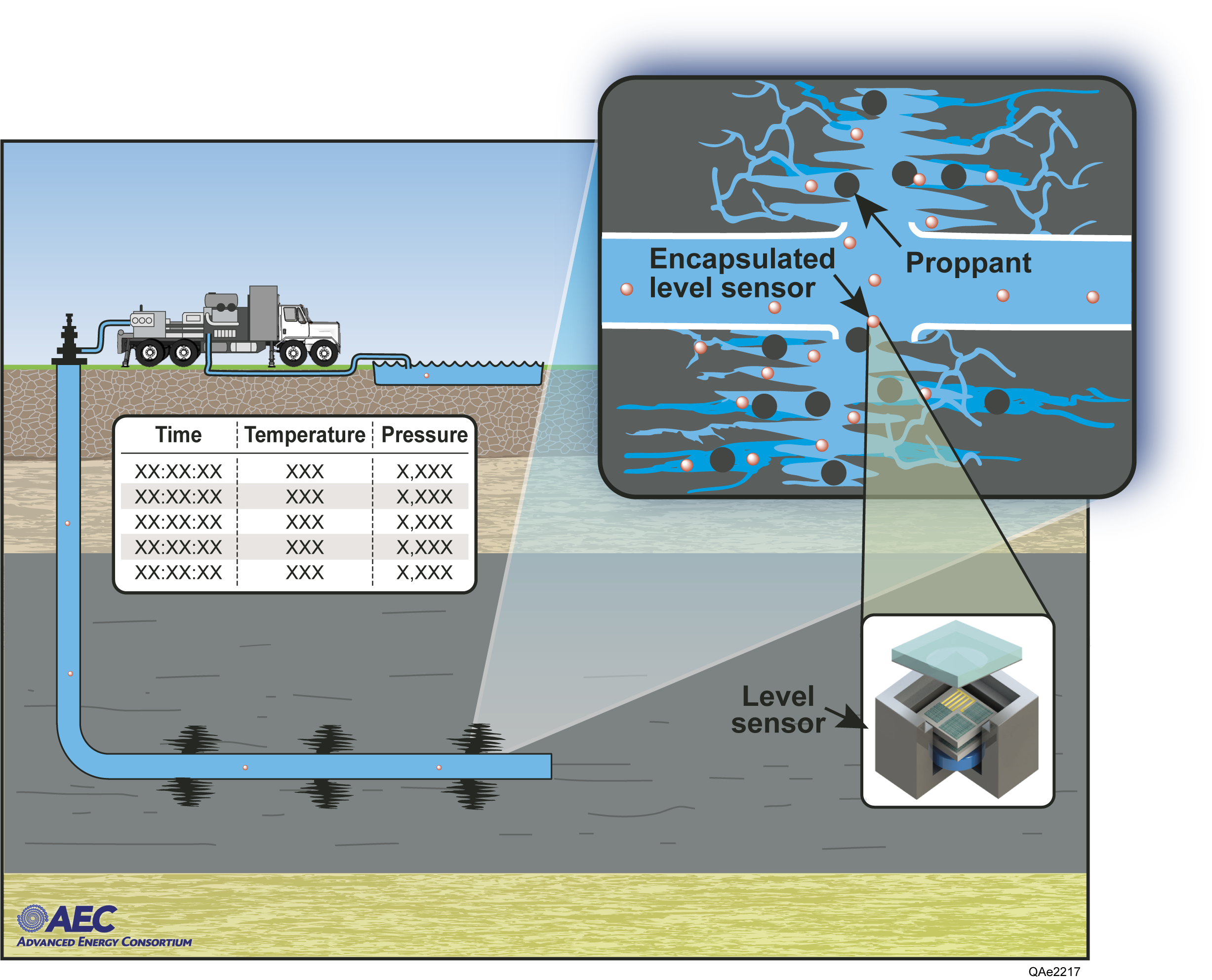
Electromagnetic (EM) proppant provides a conduit for energizing embedded nanosensors.